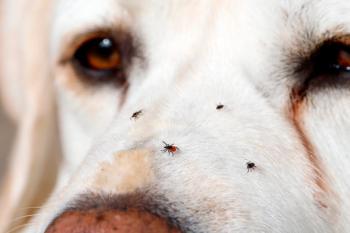
Canine and feline cryptosporidiosis and giardiasis (Proceedings)
Dogs and cats are the only domestic animals that still routinely reside in the same domicile as their owners around the world. Thus, it is important to know if the parasites they harbor are zoonotic agents or not.
Dogs and cats are the only domestic animals that still routinely reside in the same domicile as their owners around the world. Thus, it is important to know if the parasites they harbor are zoonotic agents or not. Current data suggests that dogs and cats do not routinely share their Cryptosporidium and Giardia infections with healthy people. Dogs are hosts of Cryptosporidium canis and Giardia duodenalis Assemblages C and D, and cats are hosts to Cryptosporidium felis and G. duodenalis Assemblage F. Dogs and cats (and some other animals) are sometimes infected with sub-Assemblage AI. AI is an Assemblage that is also found in people, but people usually have sub-Assemblage AII.
Unfortunately, severely immunocompromised individuals and malnourished children can be made ill by infections with C. canis and C. felis. Owners of pets should practice good sanitation and hygiene to minimize environmental contamination and contact with the infectious cysts or oocysts that may be shed by their pets.
Cryptosporidium canis oocysts are spheroid, and 5 µ in diameter. The oocysts contain 4 sporozoites and are infectious when passed. C. canis is considered to be restricted to dogs and other canids. Dogs become infected by ingesting sporulated oocyst passed in feces or in water. Released sporozoites penetrate epithelial cells of the small intestine. Infection of the stomach has occurred on occasion.
In most cases, epithelial damage is minimal, but in severe cases, infection is associated with loss of the ability to maintain water balance. Clinical signs are usually restricted to mild diarrhea, unless the host is immune suppressed or has another underlying condition such as viral infection or malignancy.
Diagnosis is by finding the oocysts in a fecal examination or by an antigen detection test. There are no drugs approved for the treatment of Cryptosporidium canis.
Cryptosporidium felis occurs in cats around the world. The life cycle and clinical signs are the same as for C. canis.
The oocysts of C. canis and C. felis are infectious when passed and are moderately resistant to environmental extremes and the routine levels of chlorine occurring in water.
Giardia duodenalis (C&D) trophozoites measure 9 to 21 µ long, 5 to 15 µ wide, and 2 to 4 µ thick. G. duodenalis (C&D) is one of the most common parasites of the domestic dog.
Trophozoites colonize the proximal small intestine and reproduce by longitudinal binary fission. Trophozoites transform into cysts with passage through the intestinal tract. Transmission from host to host is through ingestion of cysts passed in the feces.
There is very little anatomical pathology associated with Giardia infection, even when an animal has severe diarrhea associated with the infection. Many infected dogs maintain infections and remain without signs for months to years. Other dogs have irregular bouts of diarrhea followed by periods without signs. Some dogs develop chronic diarrhea, persisting until the parasites are removed by treatment.
Diagnosis is by finding cysts in the feces, either with zinc sulfate flotation, or direct saline smear; trophozoites in fresh fecal smears, or using a fecal antigen detection test.
Treatments of choice for Giardia include metronidazole and fenbendazole. Infected dogs may be treated with both products simultaneously for 5 days (Metronidazole (25 mg/kg q.24 h) and fenbendazole (50 mg/kg q.24 h). Dogs excreting cysts after treatment can be retreated for 10 days. Bathing dogs after treatment helps prevent reinfection.
Giardia duodenalis (F) have trophozoites much like those of G. duodenalis (C&D). Prevalence rates in cats range from 1% to 50%, with infections seemingly higher in cattery-housed, versus free-ranging, animals. There is little pathology associated with G. duodenalis in cats. Treatment of the cat is similar to that of the dog, metronidazole and fenbendazole.
Newsletter
From exam room tips to practice management insights, get trusted veterinary news delivered straight to your inbox—subscribe to dvm360.






